SOMME FRENCH Sector - Bouchavesnes
duda-wsm • 28 March 2019
Year of visit: 2007
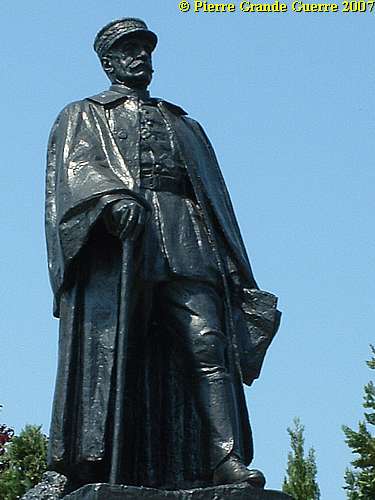
The French Sector, north of the Somme. We depart from the Belvédère de Vaux overviewing the lakes of the Somme, next we visit Bouchavesnes.
Later on the next two pages we will continue to Rancourt to vist its French and German cemeteries. In the last 2 photo pages of the French Front Sector of the Somme chapter we will visit the the former front sector, south of the Somme.
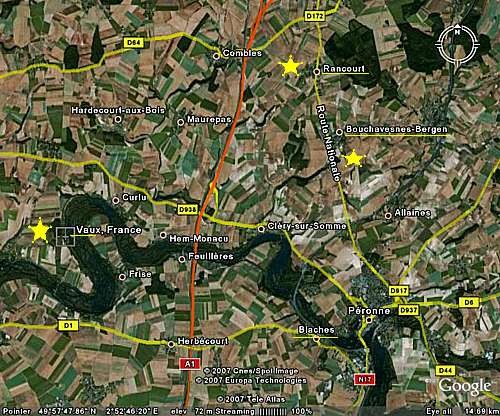
We start at the French Jump-Off Line with a panorama view from the Belvedère de Vaux over the marshes and lakes of the meandering Somme into the direction of Curlu ...

... and to Hem, the first targets, which General Fayolle's VIth Army would reach the first day of the Battle of the Somme.
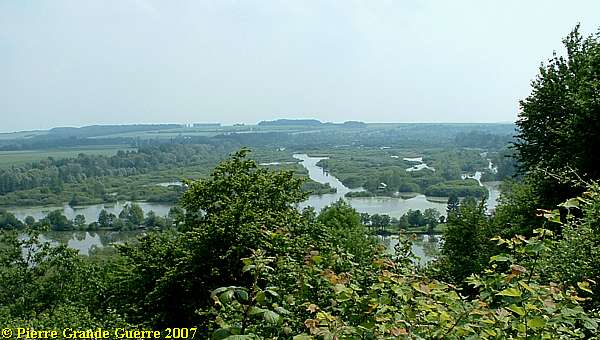
General Fayolle's VIth Army
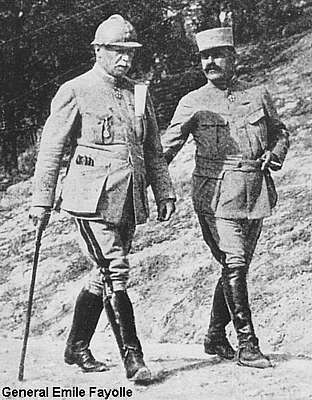
At the start of the Battle of the Somme in July 1916 General Fayolle's VIth Army was responsible for the offensive in the French Sector. North and South of the Somme river Fayolle commanded himself the XXth Army Corps, reinforced by 39th Infantry Division and Battallions of Chasseurs Alpins.
South of the Somme General Micheller commanded the Xth Army, reinforced with the 1st Colonial Army Corps and the 35th Army Corps.

The opponents of the French were 3 German Divisions of the IInd Army of General Fritz Von Below.

On the first day of the Battle of the Somme the French reached their targets.
After conquering Curlu and Hem, north of the Somme, the French Armies had to wait for 2 weeks, before the British Army was recovering from it's shock and disappointment of the heavy losses it suffered, and it captured Mametz Wood.
Then the French continued their offensive, in the northern sector.

South of the Somme General Micheler reached all his targets around 20 July 1916 via Dompierre-Becquincourt, Fay, Soyécourt, Plateau de Flaucourt, until Biaches.
But the French failed to take Péronne, and more to the south, Chaulnes.
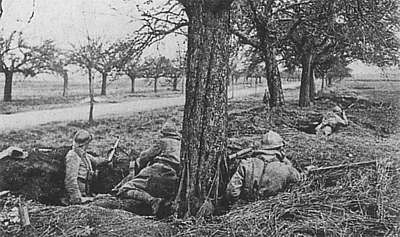
On 20 July 1916 the French Armies captured in their northern sector Combles until the lines at Hardecourt
and the Wood of Pierre St. Vaast.
On 12 september 1916 the French Armies reached the sector of Bouchavesnes, Rancourt, and Sailly Sallisel, and would get stuck there.
Situation map and the battle order of the belligerent parties along the Somme Front
Situation map and the battle order of the belligerent parties along the Somme Front
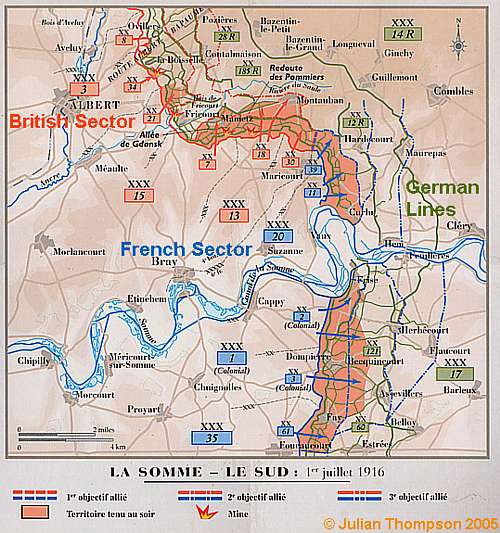
Arthur Banks' sketch o
f the French Sector of the 1916 Battle of the Somme.
I marked with stars those locations, which we have visited.
I marked with stars those locations, which we have visited.
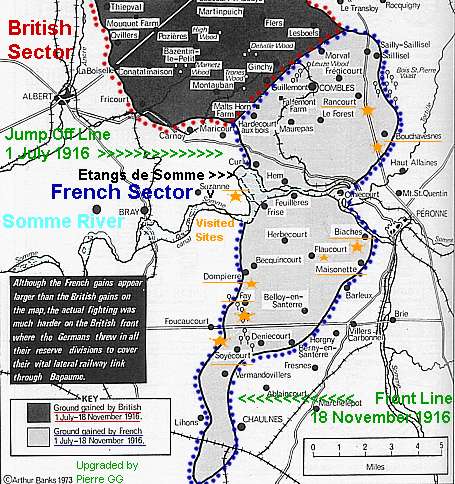
We enter the village of Bouchavesnes from the Route Nationale 17, from Rancourt to Péronne, ....
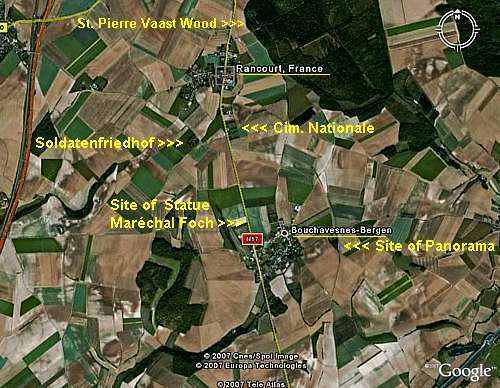
.... passing this statue of Maréchal Foch.
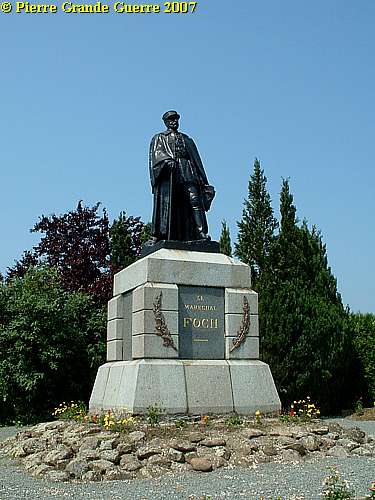
This statue commemorates the capture of Bouchavesnes on 12 September 1916, and again the capture by the British forces on 1 September 1918. Of course it commemorates also Marshall Foch himself , being the Commander in Chief of the Allied Forces in 1918.
Foch thought afterwards that Bouchavesnes was the most significant sector of the French Somme Offensive of 1916!

The Battlefield around Bouchavesnes used to be a salient, from St. Pierre Vaast Wood, around Bouchavesnes, east of the Route Nationale, bending back at the south following the left bank of the Somme. View from the east to the village of Bouchavesnes.

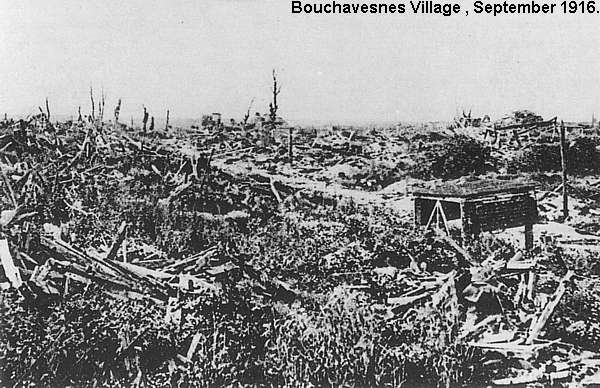
Next to the village church stands a memorial.

Outside and east of the village I made this panorama view of the former battlefield from south to north.
Centre on the horizon: Rancourt. Right on the horizon: St. Pierre Vaast Wood.
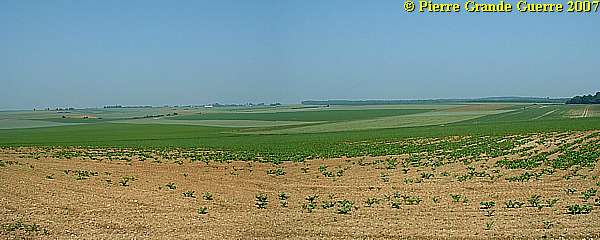
Besides the statue and a memorial cross in the village, there are hardly any relics to detect.
The only relic of the period that I found, was this German 77 mm shell, lying at my feet.
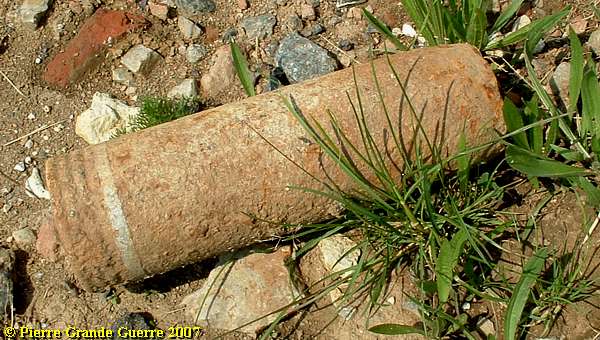
A view from the same location north-eastward, to the tip of the former small salient.
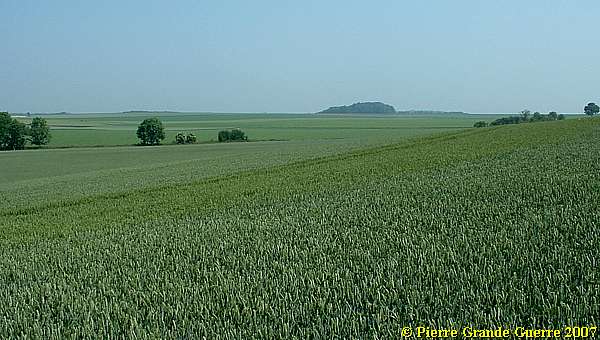
We return to the Route Nationale 17 to go northward to visit the French National Cemetery, and later the Deutscher Soldatenfriedhof just outside Rancourt village.
A view from the same spot outside Bouchavesnes to Rancourt.
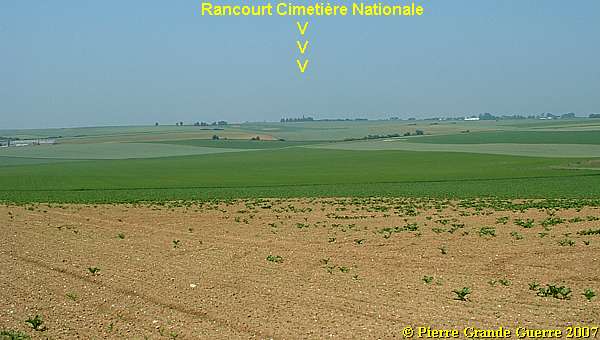
Continue
to the next chapter: " Rancourt Cimetière National
"

Inleiding: Franz Von Papen & Werner Horn; schaker en pion Onlangs stuitte ik in een oud boek (1) van 1919 op een opmerkelijk verhaal over een Duitse Luitenant, die in begin februari 1915 een half geslaagde bomaanslag pleegt op een spoorbrug over een grensrivier tussen de Verenigde Staten en Canada. Ook al staat de bekentenis van de dader, Werner Horn, deels in het boek te lezen, de naam van zijn opdrachtgever zal Horn blijven verzwijgen. Na wat verder zoeken vond ik ook de naam van Horn’s opdrachtgever, Franz von Papen, een van de aangeklaagden van het latere Neurenberg Proces in 1946. In een Grote Oorlog als de Eerste Wereldoorlog is Horn’s aanslag op de brug uiteraard slechts een bescheiden wapenfeit. Toch vermoed ik dat dit relatief onbekende verhaal, dat de geschiedenis is ingegaan als de “ Vanceboro International Bridge Bombing ”, nog interessante kanten kent. Het is onder andere een spionageverhaal over hoe in een groter plan een sluwe schaker zijn naïeve pion offert. Beknopte situatieschets Canada en de Verenigde Staten in 1915

This trip we start at the Léomont near Vitrimont and we will with some exceptions concentrate on the Battle of Lorraine of August-September 1914 in the area, called, the “Trouée de Charmes”, the Gap of Charmes. After the Léomont battlefield we continue our explorations to Friscati hill and its Nécropole Nationale. Next we pay a visit to the battlefield of la Tombe to go on to the Château de Lunéville. There we cross the Vezouze to move on southward to the Bayon Nécropole Nationale. At Bayon we cross the Moselle to pass Charmes for the panorama over the battlefield from the Haut du Mont. North-west of Charmes we will visit the British Military Cemetery containing 1918 war victims. From Charmes we go northward to the battlefield of the First French Victory of the Great War, the Battle of Rozelieures of 25 August 1914. North of Rozelieures we will visit the village of Gerbéviller. From there we make a jump northward to visit the ruins of Fort de Manonviller to finish with an interesting French Dressing Station bunker, west of Domjevin.

Though we depart from Badonviller in the Northern Vosges , we make a jump northward to the east of Lunéville and Manonviller . We start at Avricourt on the border of Alsace and Lorraine. From the Avricourt Deutscher Soldatenfriedhof we explore the southern Lorraine battlefields ; the mine craters of Leintrey , the Franco- German war cemetery and Côte 303 at Reillon , and some German bunkers near Gondrexon , Montreux , and Parux .

North-east of Nancy, east of Pont-à-Mousson, and south-east of Metz we visit the battlefields of the Battle of Morhange of 14 until 20 August 1914. We follow mainly topographically the route of the French advance eastward over the Franco-German border of 1871-1918. During this visit, we try to focus on the day that the momentum of the battle switched from the French side to the advantage of the Bavarian side: the day of 20 August 1914, when the Bavarians rapidly re-conquered the territory around Morhange , being also the day of the start of their rather successful “Schlacht in Lothringen”. We will visit beautiful landscapes of the "Parc Naturel Régional de Lorraine", memorials, ossuaries, and cemeteries. Sometimes we will divert to other periods of the Great War, honouring Russian and Romanian soldiers, who died in this sector. We start our route at the border village of Manhoué, and via Frémery, Oron, Chicourt, Morhange, Riche, Conthil, Lidrezing, Dieuze, Vergaville, Bidestroff, Cutting, Bisping we will finish in Nomeny and Mailly-sur-Seille, where the Germans halted their advance on 20 August 1914, and where they constructed from 1915 some interesting bunkers.

South of Manhoué we start this trip at Lanfroicourt along the French side of the Franco-German 1871-1918 border, marked by the meandering Seille river. We visit some French bunkers in Lanfroicourt, near Array-et-Han and in Moivrons. From there we go northward to the outskirts of Nomeny and the hamlet of Brionne to visit the ( second ) memorial, commemorating the events in Nomeny of 20 August 1914. We continue westward to finish at the Monument du Grand Couronné at the Côte de Géneviève, a former French artillery base, which offers several panoramic views over the battlefield.

North of Pont-à-Mousson and south of Metz, we explore the relics of German bunkers and fortifications along the Franco-German 1871-1918 border. We start at Bouxières-sous-Froidmont to visit the nearby height of the Froidmont on the front line. This time we will show only a part of the Froidmont, focusing on its military significance. From the Froidmont we continue via Longeville-lès-Cheminot and Sillegny to the “Forêt Domaniale de Sillegny” to explore some artillery ammunition bunkers. Next we continue to Marieulles for its three interesting bunkers and to Vezon for its line of ammunition depot bunkers. From Vezon we continue to the “Deutscher Kriegsgräberstätte Fey – Buch”. From Fey we go eastward, passing 6 bunkers near Coin-lès-Cuvry to finish our trip at the top construction of the “Feste Wagner” or “Fort Verny”, north of Verny.

We concentrate on the German side of the front around "Markirch", Sainte Marie-aux-Mines, the so-called "Leber" front sector . We first pay a visit to the Sainte-Marie-aux-Mines Deutscher Soldatenfriedhof, and next to the southern side of the Col de Ste. Marie for the many interesting bunkers of the German positions at the Bernhardstein, at the north-eastern slopes of the Tête du Violu. On the next photo page about the Haut de Faîte we will continue with a visit to the northern side of the pass and the "Leber" sector.



